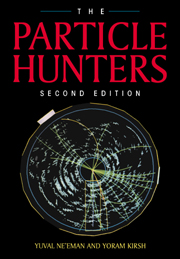Book contents
- Frontmatter
- Contents
- Preface to the first edition
- Preface to the second edition
- 1 The building blocks of the atom
- 2 Physical laws for small particles
- 3 The discoveries of the 1930s and 1940s
- 4 Particle accelerators — or from hunters to farmers
- 5 Strange particles
- 6 Basic forces and the classification of particles
- 7 Conservation laws
- 8 Short-lived particles
- 9 To the quarks — via the eightfold way
- 10 More quarks — or charm, truth and beauty
- 11 The Standard Model and beyond
- Appendix 1 Properties of semi-stable particles
- Appendix 2 The Greek alphabet
- Name index
- Subject index
9 - To the quarks — via the eightfold way
Published online by Cambridge University Press: 05 August 2012
- Frontmatter
- Contents
- Preface to the first edition
- Preface to the second edition
- 1 The building blocks of the atom
- 2 Physical laws for small particles
- 3 The discoveries of the 1930s and 1940s
- 4 Particle accelerators — or from hunters to farmers
- 5 Strange particles
- 6 Basic forces and the classification of particles
- 7 Conservation laws
- 8 Short-lived particles
- 9 To the quarks — via the eightfold way
- 10 More quarks — or charm, truth and beauty
- 11 The Standard Model and beyond
- Appendix 1 Properties of semi-stable particles
- Appendix 2 The Greek alphabet
- Name index
- Subject index
Summary
In the 1960s and 1970s the list of hadronic resonances rapidly expanded. Physicists watched its growth with mixed feelings. On the one hand the many new particles would provide them with a rich field of investigation for many years to come, but on the other, the inability to explain the connections between the various particles pointed only too clearly to the lack of a comprehensive theory concerning the nature of sub-atomic particles. The classification into four families no longer provided a means of bringing order into the chaos, since two of the families — the mesons and baryons — had flourished, and eventually added tens upon tens of new members to their number. In the late 1950s and early 1960s several attempts were made to draw up a new classification scheme which would divide the two large hadronic families into sub-families on the basis of the quantum numbers of the particles. Such a scheme was needed not only as an aid to finding one's way around the jungle of particles, but it could also be the first step towards finding a satisfactory theory which would explain the existence and properties of all the particles.
Experience had shown that when certain observations could not be fitted into a comprehensive theory, it was often useful to sum up the abstracted regularities in heuristic formulae or illustrative tables, even if their theoretical basis was not yet clear.
- Type
- Chapter
- Information
- The Particle Hunters , pp. 195 - 225Publisher: Cambridge University PressPrint publication year: 1996



